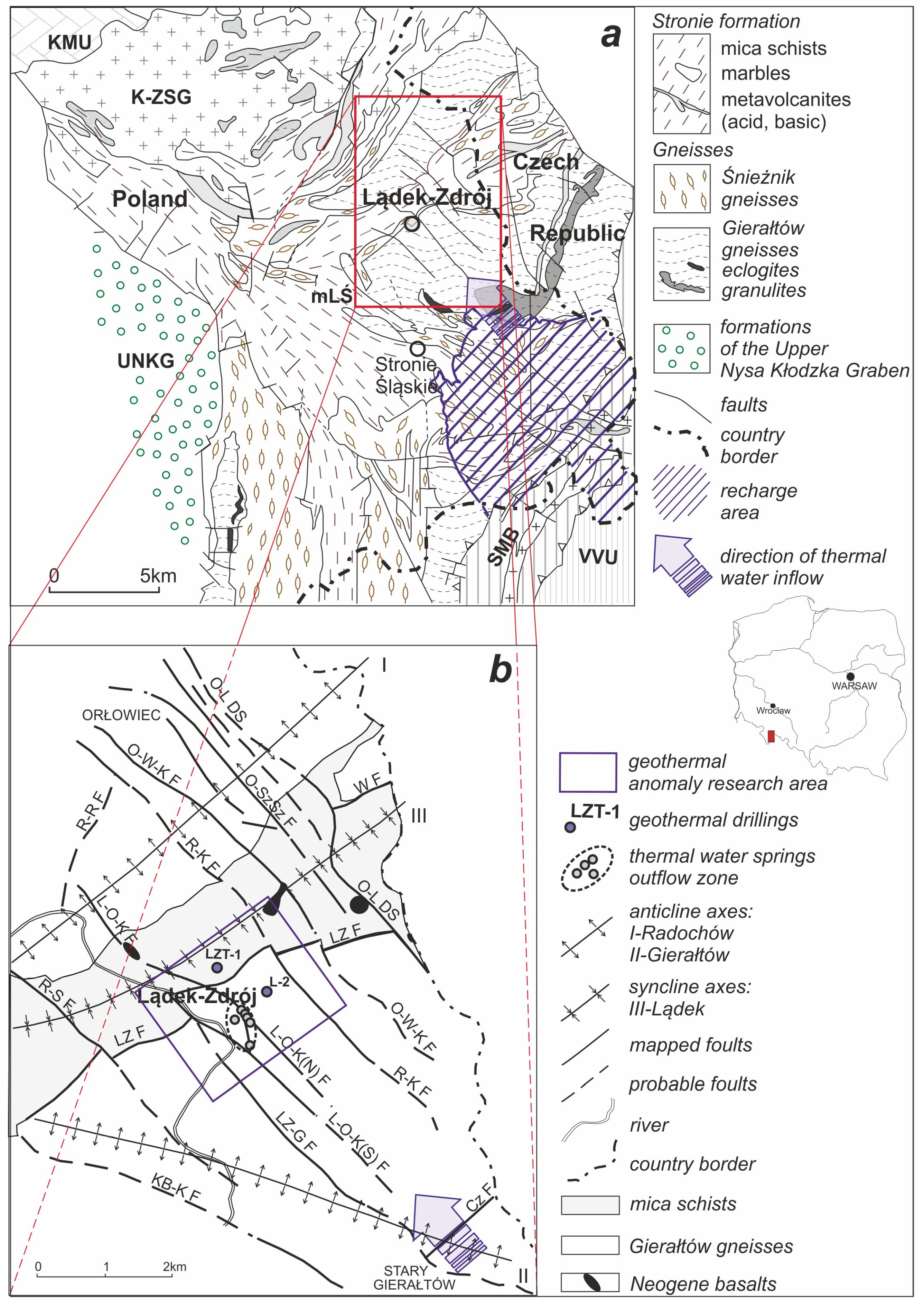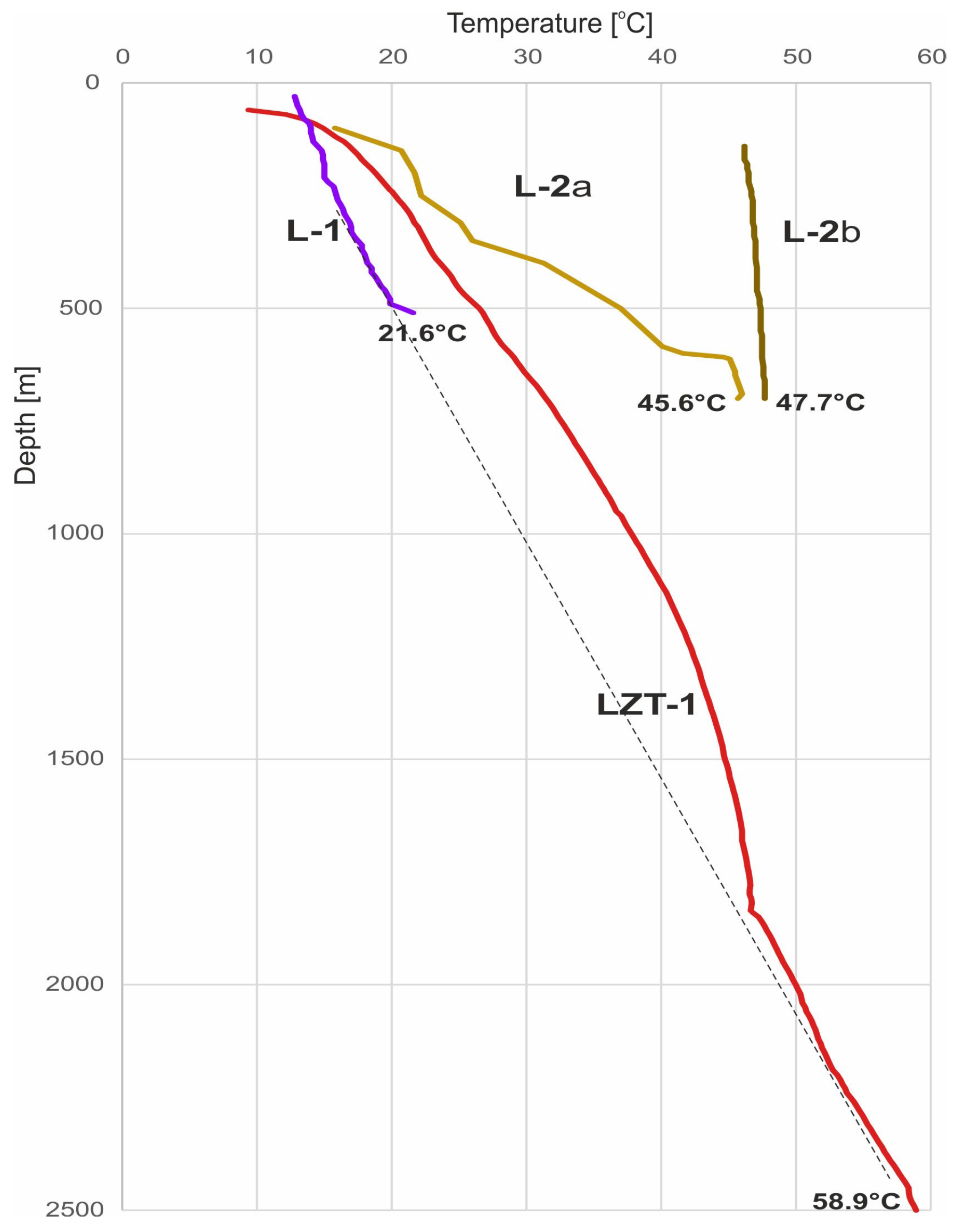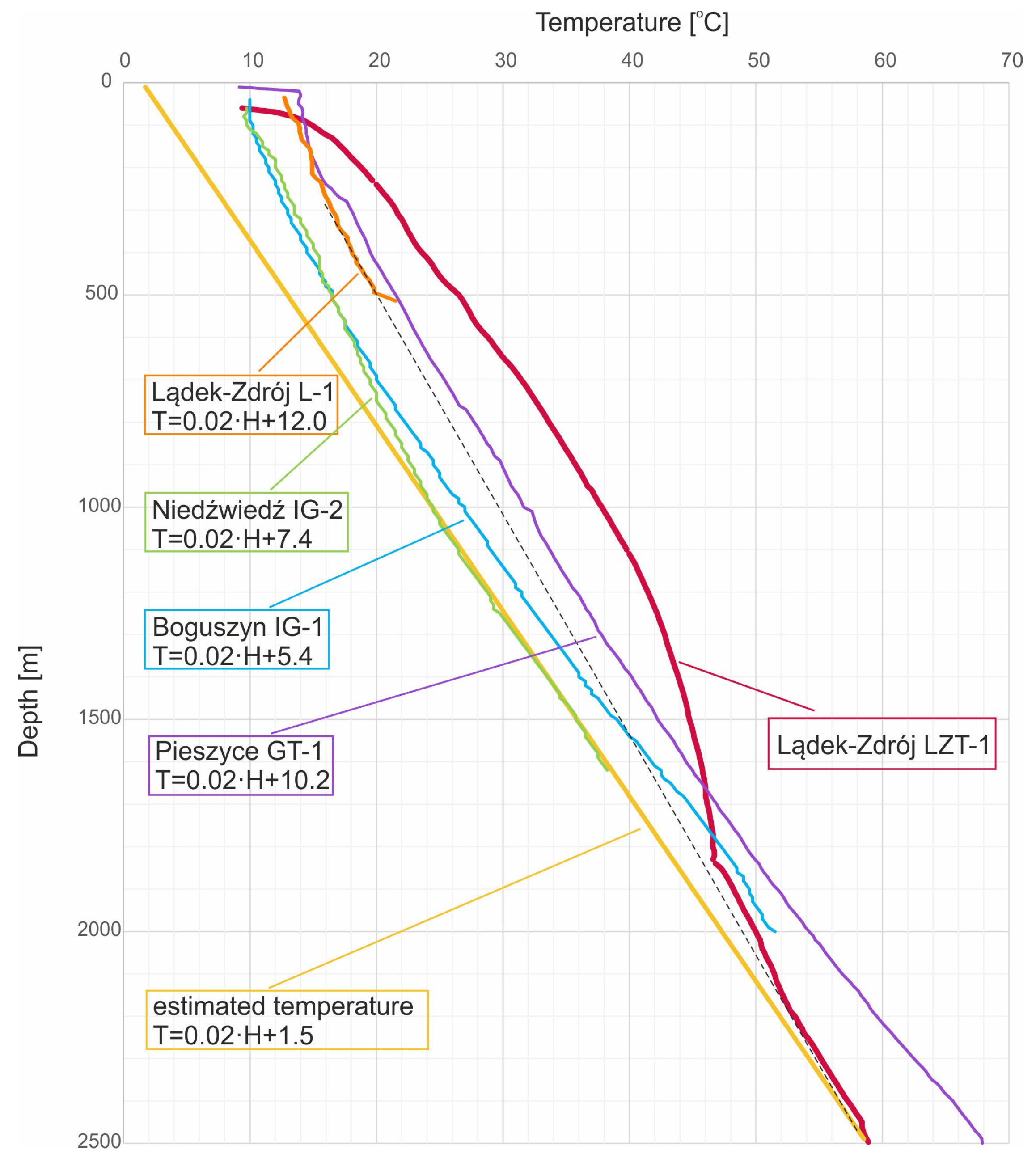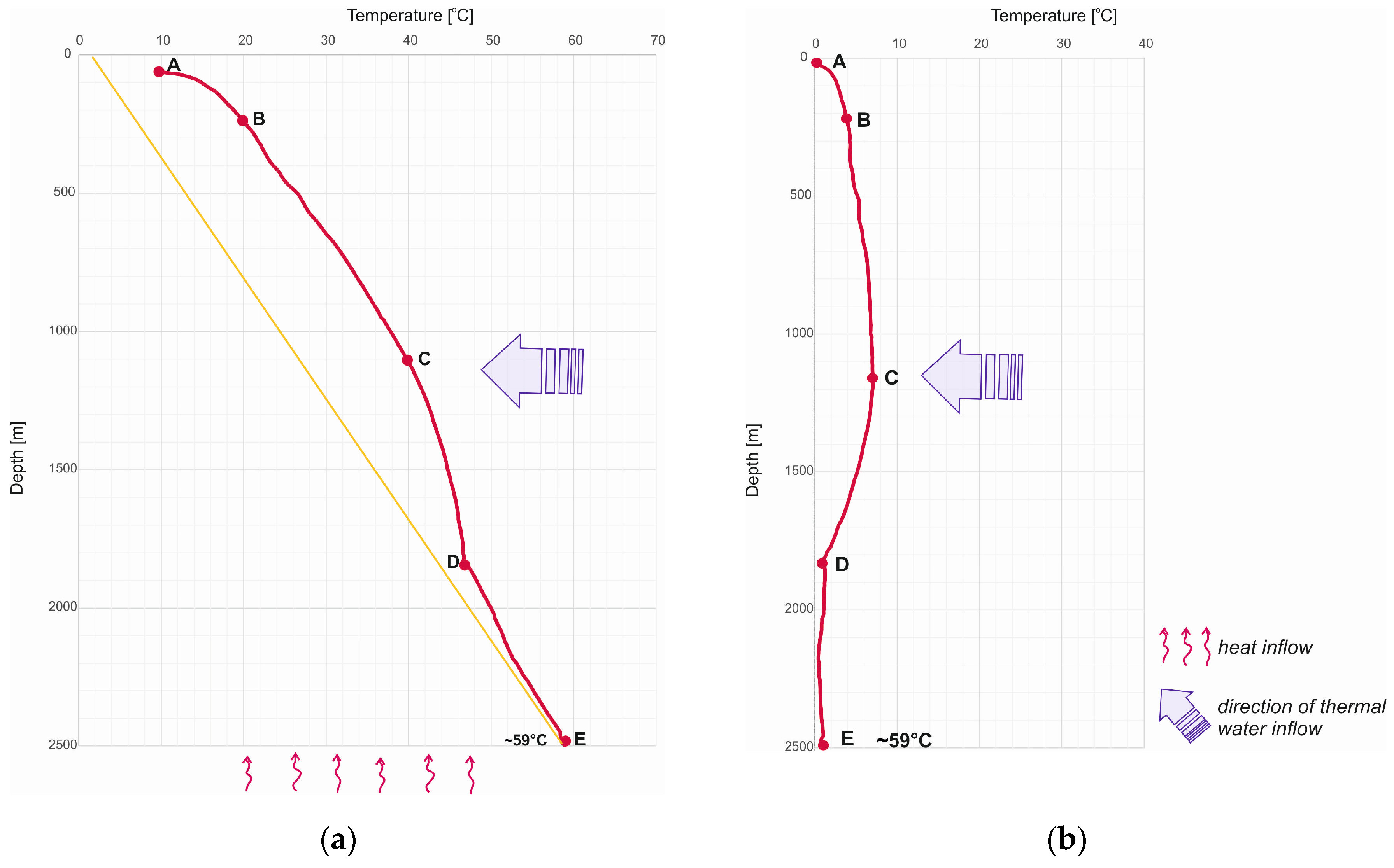Temperature Variations in Deep Thermal Well LZT-1 in Lądek-Zdrój (Bohemian Massif; SW Poland)—Evidence of Geothermal Anomaly and Paleoclimatic Changes
Abstract
1. Introduction
1.1. Geological Background

1.2. Characteristics of the Thermal Water Deposit
- an outflow of the thermal waters at the ground surface takes place in the bifurcation zone of the Lądek-Orłowiec-Karpno (N) and (S) faults (an anomaly with two clearly marked maxima in the region of the faults);
- the thermal waters are present in the area contained between the Lądek-Orłowiec-Karpno and Rasztowiec-Karpno faults (since the area north of the Lądek Zdrój resort shows elevated geothermal degree values);
- the flow of the thermal waters is concentrated (a small horizontal extent of anomalies), and the zone of convective heat inflow in Lądek-Zdrój is limited to the immediate vicinity of the thermal water migration paths.
1.3. Geothermal Settings of the Study Area
1.4. Paleoclimatic Conditions
2. Materials and Methods
3. Results
4. Discussion
4.1. Geothermal Anomaly
4.2. Activation of the Water System
5. Conclusions
Author Contributions
Funding
Data Availability Statement
Acknowledgments
Conflicts of Interest
References
- Golovanova, I.V.; Sal’manova, R.Y.; Tagirova, C.D. Method for deep temperature estimation with regard to the paleoclimate influence on heat flow. Russ. Geol. Geophys. 2014, 55, 1130–1137. [Google Scholar] [CrossRef]
- Majorowicz, J.; Wybraniec, S. New terrestrial heat flow map of Europe after regional paleoclimatic correction application. Int. J. Earth Sci. 2011, 100, 881–887. [Google Scholar] [CrossRef]
- Szewczyk, J. Estymacja gęstości strumienia cieplnego metodą modelowań własności termicznych ośrodka. Przegląd Geol. 2001, 49, 1083–1088. [Google Scholar]
- Szewczyk, J.; Gientka, D. Terrestrial heat flow density in Poland—A new approach. Geol. Q. 2009, 53, 125–140. [Google Scholar]
- Szewczyk, J. Ślady zmian klimatycznych plejstocenu oraz holocenu w profilach temperatury w głębokich otworach wiertniczych na Niżu Polskim. Przegląd Geol. 2002, 50, 1109–1113. [Google Scholar]
- Szewczyk, J. Geofizyczne oraz hydrogeologiczne warunki pozyskiwania energii geotermicznej w Polsce. Przegląd Geol. 2010, 58, 566–573. [Google Scholar]
- Galushkin, Y. Numerical simulation of permafrost evolution as a part of sedimentary basin modeling: Permafrost in the Pliocene—Holocene climate history of the Urengoy field in the West Siberian basin. Can. J. Earth Sci. 1997, 34, 935–948. [Google Scholar] [CrossRef]
- Kukkonen, I.T.; Golovanova, I.V.; Khachay, Y.V.; Druzhinin, V.S.; Kosarev, A.M.; Schapov, V.A. Low geothermal heat flow of the Urals fold belt—Implication of low heat production, fluid circulation or palaeoclimate? Tectonophysics 1997, 276, 63–85. [Google Scholar] [CrossRef]
- Clauser, C.; Giese, P.; Huenges, E.; Kohl, T.; Lehmann, H.; Rybach, L.; Safanda, J.; Wilhelm, H.; Windloff, K.; Zoth, G. The thermal regime of the crystalline continental crust: Implications from the KTB. J. Geophys. Res. 1997, 102, 18417–18441. [Google Scholar] [CrossRef]
- Šafanda, J.; Rajver, D. Signature of the last ice age in the present subsurface temperatures in the Czech Republic and Slovenia. Global Planet. Change 2001, 29, 241–257. [Google Scholar] [CrossRef]
- Kukkonen, I.T.; Gosnold, W.D.; Šafanda, J. Anomalously low heat flow density in eastern Karelia, Baltic Shield. Tectonophysics 1998, 291, 235–249. [Google Scholar] [CrossRef]
- Kukkonen, I.T.; Jõeleht, A. Weichselian temperatures from geothermal heat flow data. J. Geophys. Res. 2003, 108, 2163. [Google Scholar] [CrossRef]
- Golovanova, I.V.; Puchkov, V.N.; Sal’manova, R.Y.; Demezhko, D.Y. A new version of the heat flow map of the Urals with paleoclimatic corrections. Dokl. Earth Sci. 2008, 422, 1153–1156. [Google Scholar] [CrossRef]
- Szewczyk, J. Wpływ zmian klimatycznych na temperaturę podpowierzchniową Ziemi. Przegląd Geol. 2005, 53, 77–86. [Google Scholar]
- Szewczyk, J.; Gidziński, T.; Gientka, D. Anomalia geotermiczno-hydrogeochemiczna rejonu Krzemianka–Udryń—Pozostałość głębokiej zmarzliny. Mat. Symp. Współczesne Probl. Hydrogeol. 2003, XI, 229–236. [Google Scholar]
- Szewczyk, J.; Nowicki, Z.; Gientka, D. Występowanie głębokiej zmarzliny w okresie zlodowacenia Wisły na obszarze Niżu Polskiego—Implikacje paleohydrogeologiczne oraz geotermiczne. Mat. Symp. Współczesne Probl. Hydrogeol. 2007, XIII, 203–211. [Google Scholar]
- Puziewicz, J.; Czechowski, L.; Krysiński, L.; Majorowicz, J.; Matusiak-Małek, M.; Wróblewska, M. Litosphere thermal structure at the eastern margin of the Bohemian Massif: A case petrological and geophysical study of the Niedźwiedź amphibolite massif (SW Poland). Int. J. Earth Sci. 2012, 101, 1211–1228. [Google Scholar] [CrossRef]
- Majorowicz, J. Permafrost at the ice base of recent pleistocene glaciations–inferences from borehole temperature profiles. Biull. Geogr.—Phys. Geogr. Ser. 2012, 5, 7–28. [Google Scholar] [CrossRef][Green Version]
- Majorowicz, J.; Šafanda, J. Heat flow variation with depth in Poland: Evidence from equilibrium temperature logs in 2.9-km-deep well Toruń-1. Int. J. Earth Sci. 2008, 97, 307–315. [Google Scholar] [CrossRef]
- Šafanda, J.; Szewczyk, J.; Majorowicz, J. Geothermal evidence of very low glacial temperatures on a rim of the Fennoscandian ice sheet. Geophys. Res. Lett. 2004, 31, L07211. [Google Scholar] [CrossRef]
- Szewczyk, J.; Nawrocki, J. Deep-seated relict permafrost in northeastern Poland. Boreas 2011, 40, 385–388. [Google Scholar] [CrossRef]
- Mottaghy, D.; Majorowicz, J.; Rath, V. Ground surface temperature histories reconstructed from boreholes in Poland: Implications for spatial variability. In The Polish Climate in the European Context: An Historical Overview; Przybylak, R., Majorowicz, J., Brázdil, R., Kejna, M., Eds.; Springer: Berlin/Heidelberg, Germany, 2009; pp. 375–387. [Google Scholar]
- Förster, A. Analysis of borehole temperature data in the Northeast German Basin: Continuous logs versus bottom-hole temperatures. Pet. Geosci. 2001, 40, 241–254. [Google Scholar] [CrossRef]
- Majorowicz, J. Wieloznaczność tektonicznej interpretacji rozkładu pola geotermicznego na obszarach platformowych Polski. Przegląd Geol. 1982, 30, 86–94. [Google Scholar]
- Majorowicz, J.; Šafanda, J.; Przybylak, R.; Wójcik, G. Ground Surface Temperature History in Poland in the 16th-20th Centuries Derived from the Inversion of Geothermal Profiles. Pure Appl. Geophys. 2004, 161, 351–363. [Google Scholar] [CrossRef]
- Majorowicz, J.; Grad, M. Differences between Recent Heat Flow Maps of Poland and Deep Thermo-Seismic and Tectonic Age Constraints. Int. J. Terr. Heat. Flow. Appl. Geotherm. 2020, 3, 11–19. [Google Scholar] [CrossRef]
- Majorowicz, J. Review of the Heat Flow Mapping in Polish Sedimentary Basin across Different Tectonic Terrains. Energies 2021, 14, 6103. [Google Scholar] [CrossRef]
- Clauser, C. Thermal Signatures of Heat Transfer Processes in the Earth’s Crust; Springer: Berlin/Heidelberg, Germany, 1999. [Google Scholar]
- Kudrewicz, R. A 3D model of the thermal field within the Polish Carpathians and the Carpathian Foredeep (S Poland). Geol. Q. 2021, 65, 1–26. [Google Scholar] [CrossRef]
- Don, J. Góry Złote i Krowiarki jako elementy składowe metamorfiku Śnieżnika. Geol. Sudet. 1964, I, 79–117. [Google Scholar]
- Gierwielaniec, J.Z. geologii Lądka-Zdroju. Pr. Nauk. Inst. Geotech. PWr. 1970, 5, 1–43. [Google Scholar]
- Żelaźniewicz, A. Przeszłość geologiczna. In Przyroda Dolnego Śląska; Fabiszewski, J., Ed.; PAN—Oddział we Wrocławiu: Wrocław, Poland, 2005; pp. 61–134. [Google Scholar]
- Gierwielaniec, J. Lądek Zdrój i jego wody mineralne. Kwart. Geol. 1968, 12, 680–692. [Google Scholar]
- Żelaźniewicz, A.; Aleksandrowski, P.; Buła, Z.; Karnkowski, P.H.; Konon, A.; Oszczypko, N.; Ślączka, A.; Żaba, J.; Żytko, K. Regionalizacja Tektoniczna Polski; Wydawnictwo Komitetu Nauk Geologicznych Polskiej Akademii: Wrocław, Poland, 2011. [Google Scholar]
- Birkenmajer, K.; Pecskay, Z.; Grabowski, J.; Lorenc, M.W.; Zagożdżon, P.P. Radiometric dating of the Tertiary volcanics in Lower Silesia, Poland. II. K-Ar dating and paleomagnetic data from Neogene basanites near Lądek-Zdrój, Sudetes Mts. Ann. Soc. Geol. Polon. 2002, 72, 119–129. [Google Scholar]
- Kiełczawa, B.; Ciężkowski, W.; Wąsik, M.; Rasała, M. Hydrochemical Characteristics of Thermal Water Reservoir in Lądek-Zdrój in Light of Research into the Borehole LZT-1—The Deepest Borehole in the Sudetes (SW Poland). Energies 2021, 14, 1009. [Google Scholar] [CrossRef]
- Ciężkowski, M.; Ciężkowski, W. Źródła Lądka Zdroju. Historia i badania. Balneol. Pol. 1983, XXVII, 5–19. [Google Scholar]
- Ciężkowski, W. Hydrogeologia i hydrochemia wód termalnych Lądka-Zdroju. Probl. Uzdrow. 1980, 4, 125–193. [Google Scholar]
- Zuber, A.; Weise, S.; Osenbrück, K.; Grabczak, J.; Ciężkowski, W. Age and recharge area of thermal waters in Lądek Spa (Sudeten, Poland) deduced from environmental isotope and noble gas data. J. Hydrol. 1995, 167, 327–349. [Google Scholar] [CrossRef]
- Ciężkowski, W. Studium Hydrogeochemii wód Leczniczych Sudetów Polskich; Prace Naukowe Instytutu Geotechniki Politechniki Wrocławskiej; Monografie 19; Wydawnictwo Politechniki Wrocławskiej: Wrocław, Poland, 1990. [Google Scholar]
- Dowgiałło, J. Wody termalne Sudetów. Acta Geol. Pol. 1976, 26, 617–643. [Google Scholar]
- Dowgiałło, J. Geochemiczne wskaźniki temperatury i ich zastosowanie do sudeckich wód termalnych. In Proceedings of the Mat. Symp. “Stan Rozpoznania i Perspektywy Wykorzystania wód Termalnych”, Warszawa-Kraków, Polska, 24–25 October 1985. [Google Scholar]
- Dowgiałło, J.; Florkowski, T.; Grabczak, J. Tritium and 14C dating of Sudetic thermal waters. Bull. Pol. Acad. Sci.-Earth Sci. 1974, 22, 101–109. [Google Scholar]
- Dowgiałło, J.; Hałas, S.; Porowski, A. Isotope temperature indicators of thermal waters in South-Western Poland. In Proceedings of the World Geothermal Congress, Antalya, Turkey, 24–29 April 2005; pp. 1–8. [Google Scholar]
- Porowski, A.; Dowgiałło, J. Application of selected geothermometers to exploration of low-enthalpy thermal water: The Sudetic Geothermal Region in Poland. Environ. Geol. 2009, 58, 1629–1638. [Google Scholar] [CrossRef]
- Kiełczawa, B. Determination of Reservoir Temperatures of Low-Enthalpy Geothermal Systems in the Sudetes (SW Poland) Using Multicomponent Geothermometers. Water 2023, 15, 422. [Google Scholar] [CrossRef]
- Szarszewska, Z. Dokumentacja Hydrogeologiczna wód Leczniczych z Utworów Prekambru Ujętych Odwiertem L-600 w Lądku Zdroju, PPOTU: Warszawa, Poland, 1971; unpublished.
- Kiełczawa, B.; Liber-Makowska, E. Warunki geotermiczne rejonu Lądka-Zdroju. Tech. Poszuk. Geol. Geoterm. Zrównoważony Rozw. 2017, 2, 105–115. [Google Scholar]
- Szarszewska, Z.; Madej, E. Sprawozdanie z Badań Związanych z Poszukiwaniem wód Termalnych w Lądku Zdroju, BP Balneoprojekt: Warszawa, Poland, 1974; unpublished.
- Hurter, S.; Haenel, R. Atlas of geothermal resources in Europe; European Commission: Luxembourg, 2002. [Google Scholar]
- Myslil, V.; Stibitz, M.; Frydrych, V. Geothermal Energy Potential of Czech Republic. In Proceedings of the World Geothermal Congress, Antalya, Turkey, 24–29 April 2005. [Google Scholar]
- Bruszewska, B. Warunki geotermiczne Dolnego Śląska. Przegląd Geol. 2000, 48, 639–643. [Google Scholar]
- Plewa, S. Rozkład parametrów geotermalnych na obszarze Polski; Wyd. CPPGSMiE PAN: Kraków, Poland, 1994; pp. 1–38. [Google Scholar]
- Majorowicz, J.; Plewa, S. Study of Heat Flow in Poland with Special Regard to Tectonophysical Problems. In Terrestrial Heat Flow in Europe; Čermák, V., Rybach, L., Eds.; Springer: Berlin/Heidelberg, Germany, 1979; pp. 240–252. [Google Scholar]
- Čermák, V. Review of Heat Flow Measurements in Czechoslovakia. In Terrestrial Heat Flow in Europe; Čermák, V., Rybach, L., Eds.; Springer: Berlin/Heidelberg, Germany; New York, NY, USA, 1979; pp. 152–160. [Google Scholar]
- Dowgiałło, J.; Fistek, J. New findings in the Wałbrzych-Kłodzko geothermal sub-region (Sudetes, Poland). Geothermics 2003, 32, 689–699. [Google Scholar] [CrossRef]
- Ciężkowski, W.; Płochniewski, Z. Poszukiwanie wód termalnych w rejonie Bolesławowa w Masywie Śnieżnika. Mat. Symp. Współczesne Probl. Hydrogeol. 1983, II, 262–270. [Google Scholar]
- Rasała, M.; Ciężkowski, W.; Wąsik, M.; Kiełczawa, B. Dokumentacja geologiczna z wykonania prac geologicznych niekończących się udokumentowaniem zasobów złoża kopaliny w związku z wykonaniem otworu poszukiwawczego za wodami termalnymi LZT-1 w Lądku-Zdroju. Arch. Gm. Lądek-Zdrój, 2019; unpublished. [Google Scholar]
- Kiełczawa, B.; Wąsik, M.; Szostak, K.; Rasała, M.; Ciężkowski, W. Otwór LZT-1 w Lądku-Zdroju—Obiecujący potencjał, niewykorzystane możliwości. Przegląd Geol. 2024, 72, 174–181. [Google Scholar] [CrossRef]
- Śmiszek, R. Wyniki badań fizycznych właściwości skał obszaru sudeckiego. In Badania Ciepła Radiogenicznego Skał Krystalicznych i Osadowych Obszaru Sudeckiego; Plewa, M., Ed.; Prace Geol. nr 141, Kom. Nauk. Geol. PAN: Kraków, Poland, 1996; pp. 21–53. [Google Scholar]
- Szewczyk, J. The deep-seated lowland relict permafrost from the Suwałki region (NE Poland)—Analysis of conditions of its development and preservation. Geol. Q. 2017, 61, 845–858. [Google Scholar] [CrossRef]
- Majorowicz, J. Obraz pola cieplnego Ziemi w obszarze Polski. Rocznik PTG 1974, XLIV, 425–445. [Google Scholar]
- Peters, K.; Nelson, P. Criteria to Determine Borehole Formation Temperatures for Calibration of Basin and Petroleum System Models. In Analyzing the Thermal History of Sedimentary Basins: Methods and Case Studies; Harris, N., Peters, K., Eds.; SEPM Special Publication: Tulsa, OK, USA, 2012; pp. 5–15. [Google Scholar]
- Waples, D.W.; Pacheco, J.; Vera, A. A method for correcting log-derived temperatures in deep wells, calibrated in the Gulf of Mexico. Pet. Geosci. 2004, 10, 239–245. [Google Scholar] [CrossRef]
- Waples, D.W.; Ramly, M. A statistical method for correcting log-derived temperatures. Pet. Geosci. 2001, 7, 231–240. [Google Scholar] [CrossRef]
- Zare-Reisabadi, M.; Kamali, M.R.; Mohammadnia, M.; Shabani, F. Estimation of true formation temperature from well logs for basin modeling in Persian Gulf. J. Pet. Sci. Eng. 2015, 125, 13–22. [Google Scholar] [CrossRef]
- Plewa, M.; Sroka, K. Gęstość powierzchniowego strumienia cieplnego Ziemi w rejonie sudeckim. In Badania Ciepła Radiogenicznego Skał Krystalicznych i Osadowych Obszaru Sudeckiego; Plewa, M., Ed.; Prace Geol. nr 141, Kom. Nauk. Geol. PAN: Kraków, Poland, 1996; pp. 54–60. [Google Scholar]
- Chorowska, M.; Milewicz, J.; Radlicz, K.; Rydzewski, A. Badania wgłębnej budowy geologicznej wschodniej części Dolnego Śląska. Dokumentacja wynikowa otworu Boguszyn IG-1, CUG IG Oddział Dolnośląski: Wrocław, Poland, 1984; unpublished.
- Fryziak, T. Pomiary Geofizyczne w Otworze Pieszyce GT-1; Arch. IWS sp. z o.o.: Zielona Góra, Poland, 2023. [Google Scholar]
- Corrigan, J. Correcting Bottom-Hole Temperature Data. 2003. Available online: http://www.zetaware.com/utilities/bht/default.html (accessed on 5 March 2024).
- Plewa, M.; Plewa, S.; Sroka, K.; Śmiszek, R. New determinations of the terrestrial heat flow in Poland. Bull. Pol. Acad. Sci. Earth Sci. 1995, 43, 207–223. [Google Scholar]
- Majorowicz, J.; Šafanda, J. Lithosphere Thickness from New Heat-Flow Data of the Odra Variscan Area, S-W Poland. Pure Appl. Geophys. 2018, 175, 4343–4354. [Google Scholar] [CrossRef]
- Čermák, V. Lithospheric thermal regimes in Europe. Phys. Earth Planet. Inter. 1993, 79, 179–193. [Google Scholar] [CrossRef]
- Jobmann, M.; Clauser, C. Heat advection versus conduction at the KTB: Possible reason for vertical variations in heat flow density. Geophys. J. Int. 1994, 119, 44–68. [Google Scholar] [CrossRef]
- Staśko, S.; Tarka, R. Zasilanie i Drenaż wód Podziemnych w Obszarach Górskich na Podstawie badań w Masywie Śnieżnika; No 2528; Wydawnictwo Uniwersytetu Wrocławskiego: Wrocław, Poland, 2002. [Google Scholar]
- Krásny, J.; Cislerová, M.; Čurda, S.; Datel, J.; Dvořák, J.; Grmela, A.; Hrkal, Z.; Křiž, H.; Marszałek, H.; Šantrůček, J.; et al. Podzemni Vody České Republiky. Regionálni Hydrogeologie Prostych a Mineralnych vod; Česka Geologická Služba: Praha, Czech Republic, 2012. [Google Scholar]
- Kozłowski, S. Budowa geologiczna otoczenia Jaskini Niedźwiedzia w Kletnie. In Jaskinia Niedźwiedzia w Kletnie, Badania i Udostępnianie; Jahn, A., Kozłowski, S., Wiszniowska, T., Eds.; Ossolineum: Wrocław, Poland, 1989; pp. 80–118. [Google Scholar]
- Sobczyk, A.; Kasprzak, M.; Marciszak, A.; Stefaniak, K. Zjawiska krasowe w skałach metamorficznych w Masywie Śnieżnika (Sudety Wschodnie): Aktualny stan badań oraz znaczenie dla poznania ewolucji Sudetów w późnym kenozoiku. Przegląd Geol. 2016, 64, 710–718. [Google Scholar]
- Szczygieł, J.; Sobczyk, A.; Hercman, H.; Mendecki, M.J.; Gąsiorowski, M. Damaged Speleothems and Collapsed Karst Chambers Indicate Paleoseismicity of the NE Bohemian Massif (Niedźwiedzia Cave, Poland). Tectonics 2021, 40, e2020TC006459. [Google Scholar] [CrossRef]





| Heat Flux Density mW/m2 | References |
|---|---|
| 45 | [51] |
| 50 | [2,4] |
| 55 | [52,53] |
| 60 | [54] |
| 63 | [55] |
| Sampling Depth m | Type of Rocks | Thermal Conductivity W/m·°C [References] | |
|---|---|---|---|
| [58] | [53,60] | ||
| 352.5 | Quartz schists | 2.40 (2.40) | 1.27–2.58 |
| 802.0 | Gneisses | 2.91 (3.12) | 1.89 |
| 1553.5 | 2.82 (3.25) | ||
| 1872.5 | 2.33 (2.77) | 0.94–4.86 | |
| 2331.0 | 1.84 (2.35) | ||
| Well | Geothermal Gradient °C/100 m | Author |
|---|---|---|
| LZT-1 | 1.81 | [58] |
| 1.83 (1.93) | Current research | |
| Niedźwiedź IG-2 | (2.16) | [67] |
| 1.87 | Current research | |
| Boguszyn IG-1 | 2.14 | [68] |
| 2.18 | Current research | |
| Pieszyce GT-1 | 2.23 | Current research |
| Tcorr in Thermal Equilibrium Conditions of the Well for Tsc = 3.5 h | Methods/Authors |
|---|---|
| 77.25 °C ± 9 °C | [70] |
| 74.42 °C | [64] |
| 79.7 °C | Simple correction Tsc/[70] |
| 74.33 °C | Last resort correction/[70] |
| 80.3 °C | [65,66] |
| 70.4 °C (for Heq) | In quasi-established conditions/[29] |
Disclaimer/Publisher’s Note: The statements, opinions and data contained in all publications are solely those of the individual author(s) and contributor(s) and not of MDPI and/or the editor(s). MDPI and/or the editor(s) disclaim responsibility for any injury to people or property resulting from any ideas, methods, instructions or products referred to in the content. |
© 2024 by the authors. Licensee MDPI, Basel, Switzerland. This article is an open access article distributed under the terms and conditions of the Creative Commons Attribution (CC BY) license (https://creativecommons.org/licenses/by/4.0/).
Share and Cite
Kiełczawa, B.; Ciężkowski, W.; Wąsik, M.; Szostak, K.; Sieniawska, I.; Rasała, M. Temperature Variations in Deep Thermal Well LZT-1 in Lądek-Zdrój (Bohemian Massif; SW Poland)—Evidence of Geothermal Anomaly and Paleoclimatic Changes. Energies 2024, 17, 3362. https://doi.org/10.3390/en17143362
Kiełczawa B, Ciężkowski W, Wąsik M, Szostak K, Sieniawska I, Rasała M. Temperature Variations in Deep Thermal Well LZT-1 in Lądek-Zdrój (Bohemian Massif; SW Poland)—Evidence of Geothermal Anomaly and Paleoclimatic Changes. Energies. 2024; 17(14):3362. https://doi.org/10.3390/en17143362
Chicago/Turabian StyleKiełczawa, Barbara, Wojciech Ciężkowski, Mirosław Wąsik, Karolina Szostak, Iwona Sieniawska, and Marek Rasała. 2024. "Temperature Variations in Deep Thermal Well LZT-1 in Lądek-Zdrój (Bohemian Massif; SW Poland)—Evidence of Geothermal Anomaly and Paleoclimatic Changes" Energies 17, no. 14: 3362. https://doi.org/10.3390/en17143362
APA StyleKiełczawa, B., Ciężkowski, W., Wąsik, M., Szostak, K., Sieniawska, I., & Rasała, M. (2024). Temperature Variations in Deep Thermal Well LZT-1 in Lądek-Zdrój (Bohemian Massif; SW Poland)—Evidence of Geothermal Anomaly and Paleoclimatic Changes. Energies, 17(14), 3362. https://doi.org/10.3390/en17143362






